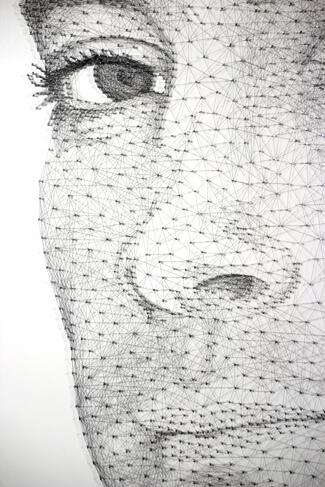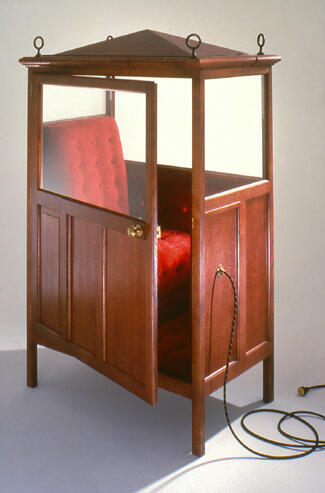Jan. 17, 2008
VCUarts Anderson Gallery's Dual Winter Exhibitions
Share this story

VCUarts Anderson Gallery, Virginia Commonwealth University's Museum of the Arts, hosts tandem exhibitions this winter that celebrate not only art but the often rigorous process of art, presenting pieces that will impress visitors with both their sense of invention and their exacting discipline.
"Familiar Faces," showing on the first floor of the Anderson Gallery, and "Gord Peteran: Furniture Meets Its Maker," on display on the gallery's second floor, will be on view from Jan. 18 to March 2. An opening reception for both exhibitions will be held on Jan. 18 from 7 p.m. to 9 p.m. The reception is free and open to the public.
Amy Moorefield, assistant director and curator of collections for the Anderson Gallery, said the exhibitions feature works that show great dedication by the artists.
"The works in both of these exhibitions are done with incredible intent and purpose," Moorefield said.
"Familiar Faces," which is curated by Sonya Clark, chair of the Craft/Material Studies Department at VCU, features nine works by artists who use cloth and thread to depict the human face. The exhibition, the third in a bi-annual series of shows curated by guest artists, is based on our instinctive identification of faces and our constant contact with cloth, according to Clark.
The artists in "Familiar Faces" – Lia Cook, Kim Kamens, Na-Jung Kim, Devorah Sperber and Xiang Yang – "see the structure of cloth in the same way that a linguist perceives language," Clark wrote in her essay about the exhibition. They utilize variations of common techniques to "construct, deconstruct and embellish cloth."
"The work is as familiar as two eyes, a nose and a mouth, the techniques as subtle as the differences between identical twins," Clark said.
Kim's "Physiognomy" exemplifies the kind of work found in the exhibition – painstaking methods resulting in engrossing portraits. Using a lit incense stick, Kim made the portraits in "Physiognomy" by burning holes in a serpentine, diaphanous silk organza. Clark explains that the work "evokes more than process" and achieves a mystic quality, in part because of the silk's ghostly nature.
Sperber uses intact spools of thread in "After Picasso" and "After the Mona Lisa 1" to interpret a pair of familiar faces. The spools are organized in blocks of color in the portraits, which are inverted and which come into surprisingly keen focus with the aid of a prism stationed in front of them. "After Picasso," the larger of the two works, includes a jaw-dropping 5,024 spools of thread.
Xian's "Relationship: Red Desire" features stitched portraits of Mao Zedong and Kim Jong-il at opposite ends of a 6-foot-long, vibrantly colored tunnel of thread. His much smaller "Newsreel," which will greet arrivals in the Anderson Gallery foyer, consists of cellophane tape strips with miniature photo portraits of celebrities.
Cook's weavings, "Big Tera" and "In the Maze," use fiber to suggest the pixilated look of computer-generated art, though the former, a portrait of an earnest young child, also contains the realistic detail of a photograph. The works were made on a digital loom.
Kamens' portraits, "Warren" and "Ken," use miles of black sewing thread wrapped around nails to create rich portraits. Clark notes that the technique is reminiscent of string ship drawings from the 1970s.

The Anderson Gallery is the latest venue to host "Gord Peteran: Furniture Meets Its Maker," which was organized by the Milwaukee Art Museum and the Chipstone Foundation with support from the Windgate Charitable Foundation.
The show is the first mid-career retrospective for Peteran, whose work plays on the line between furniture and sculpture – he has even referred to it as "furnitural."
Moorefield said Peteran's innovative pieces are an ideal fit for the Anderson Gallery, which is constantly exploring the definition of art.
"A big part of our challenge here is showing what art is and what art can be," Moorefield said.
Much of Peteran's work has an appealing tongue-in-cheek quality. An example is "Chest on Chest," a chest with a smaller replica of it stacked on top of it. When examined closely, the elegant chests reveal doodling scratched into the wood. "Up" is a nest-like creation made entirely out of carpenter's glue. "Two Bracelets" are made of pencil shavings, somehow kept connected.
"He's a fantastic craftsman and furniture-maker, but he also absolutely has a wonderful, devilish sense of humor," Moorefield said.
Peteran often toys with the viewer's expectations of furniture. "Prosthetic," for instance, is an old chair with a hole in the seat that Peteran has "reupholstered" with a raised brass seat. "An Early Table" is a collection of sticks and twigs pulled together by string into what looks like a table, and "Table Made of Wood" is a table constructed entirely of pieces of scrap wood gathered in Peteran's workshop. The works, Moorefield said, seem like an attempt "to capture the essence of furniture."
Other pieces in the 20-work show include the striking large works, "Ark," and "Maypole," and "Musical Box," a fan-shaped musical instrument that is played with a series of knobs.
Peteran and Glenn Adamson, the exhibition curator, will discuss Peteran's work and the creation of the exhibition on Feb. 18 at 5 p.m. in the Founder's Room of the VCU Siegel Center, 1200 W. Broad St. A reception in the Anderson Gallery will follow the lecture. Both events are free and open to the public.
VCUarts Anderson Gallery is free and open to the public.
Gallery hours are: Monday-Friday, 10 a.m.-5 p.m.,
and Saturday-Sunday, 1-5 p.m. For
more information, call 804-828-1522 or visit http://www.vcu.edu/arts/gallery.
Subscribe to VCU News
Subscribe to VCU News at newsletter.vcu.edu and receive a selection of stories, videos, photos, news clips and event listings in your inbox.







